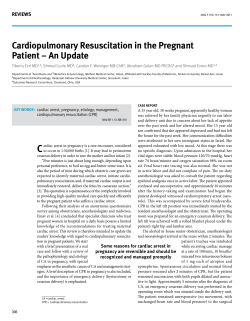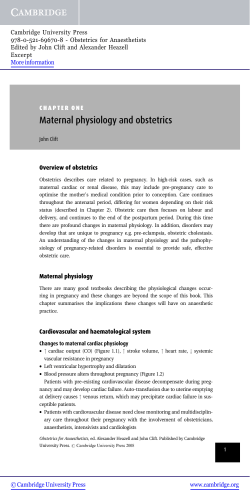
Document 14288
The pregnant cardiac patient When should I worry ? I A Joubert Department of Anaesthesia Department of Critical Care University of Cape Town ASM - Rotorua, November 2009 How common is this ? • Between 0.1 and 4% of pregnancies • International differences – – Less common in developed world • • Steady decline in rheumatic heart disease More correction of congenital lesions • Mortality reduced since 1950 – From 5.6 to 0.3 per 100 000 births Why Mothers Die 1997–1999. The Confidential Enquiries into Maternal Deaths in the United Kingdom. RCOG, 2001; 153–64 But it is important … • Accounts for – – 16.5% of all maternal deaths ! • 40% of patients have inadequate care ! Deans CL, Uebing A, Steer PJ. Cardiac disease in pregnancy. Progress in Obstetrics and Gynaecology, Vol 17, 2007, 164-182. Why the problems ? • Pregnancy increases physiologic demand – 30 – 50% increase in blood volume – 30 – 50% increase in cardiac output • Stroke volume increases early on • Heart rate increases later (25 – 30%) Hunter S, Robson SC. Adaptation of the maternal heart in pregnancy. British Heart Journal 1992;68:540-3 Big trouble ! Non-viable Congestion Overt failure Other important changes … • From the pulmonary perspective – – Steady – Steady decrease in colloid oncotic pressure increase in hydrostatic pressure • Pregnant patients are prone to – – The development of pulmonary oedema ! More importantly … • Colloid oncotic pressure is lowest – – Between 6 and 16 hours post-partum – This is when pulmonary oedema occurs ! The bottom line … • Cardiac disease – – Causes morbidity and mortality • Physiologic demand – – Responsible for timing of presentation • Pulmonary oedema a big problem – Particularly post delivery ! Also confounding the issue … • Most pregnant patients – – Have symptoms of cardiac disease • • • Fatigue Dyspnoea and orthopnoea Subtle abnormalities on examination – Are all common ! Assessing risk … How do we assess risk ? • Poor functional status – – NYHA III-IV or cyanosis • Ejection fraction < 40% • Left heart obstruction – – – – MV area of < 2.0 cm2 Aortic area of < 1.5 cm2 Gradient of > 30 mmHg • Prior cardiac event Siu SC, Sermer M, Colman JM, et al. Prospective multicenter study of pregnancy outcomes in women with heart disease. Circulation 2001; 104:515–521. How do we assess risk ? • Incidence of cardiac events – – No risk factor – One risk factor – More than one factor 5% 25 % 75 % • Identifying risk factors is important ! Siu SC, Sermer M, Colman JM, et al. Prospective multicenter study of pregnancy outcomes in women with heart disease. Circulation 2001; 104:515–521. Remember them ! • Poor functional status – – NYHA III-IV or cyanosis • Ejection fraction < 40% • Left heart obstruction – – – – MV area of < 2.0 cm2 Aortic area of < 1.5 cm2 Gradient of > 30 mmHg • Prior cardiac event Siu SC, Sermer M, Colman JM, et al. Prospective multicenter study of pregnancy outcomes in women with heart disease. Circulation 2001; 104:515–521. Particular points to identify … • A loud 4th heart sound • Any diastolic murmur • A systolic of > 3/6 Thesemurmur are always abnormal ! • Fixed splitting of the 2nd sound • An opening snap Prasad AK, Ventura HO. Valvular heart disease and pregnancy. Postgraduate Medicine 2001;110:69-88 Issues during pregnancy and labour During pregnancy • The single biggest goal – – To maintain the patient within reserve – Limitation of all physical activity – Hypertension, anaemia and infection – • Must all be treated aggressively Anticoagulation may be needed • Only heparin is absolutely safe • Warfarin – – From week 14 to middle of 3rd trimester • LMWH may be practically easier • Anticoagulation is safe 4 - 6 hours post delivery Bates SM, Greer IA, Hirsh J, Ginsberg JS. Use of antithrombotic agents during pregnancy. Chest 2004; 126:627S–644S. Antibiotic prophylaxis ? • This is no longer recommended – Not needed in vaginal delivery – Routine surgical prophylaxis is adequate • In Caesarean section AHA/ACC consensus guidelines on the use of antimicrobial prophylaxis in cardiac disease Changes during labour • Contractions are problematic – – Each injects 300 – 500 ml of volume • Potential for circulatory overload • Stroke volume also increases – – Ordinarily by about 50% • Cardiovascular demands are huge ! Post delivery care • Haemodynamics settle with time – – The first 72 hours most dangerous • This is when most deaths occur – Less need for concern later on Siu SC, Sermer M, Colman JM, et al. Prospective multicenter study of pregnancy outcomes in women with heart disease. Circulation 2001; 104:515–521. The bottom line … • Identify risk factors – – And examine the patient • Anticoagulants – – Have obvious anaesthesia implications • The post-delivery period is important – – Don’t abandon the patient Risk in valvular heart disease … Valvular lesions • Risk can be determined in two ways – – Maternal risk – Foetal or neonatal risk High maternal and foetal risk • Severe aortic stenosis • Mitral stenosis with symptoms • Aortic or mitral regurgitation with symptoms • The presence of pulmonary hypertension • Ejection fraction of < 40% • The presence of cyanosis Reimold SC, Rutherford JD. Valvular heart disease in pregnancy. NEJM 2003;349:52-9 Low maternal and foetal risk • Asymptomatic aortic valve disease • Mitral regurgitation with normal LV function • Mitral stenosis without pulmonary hypertension • Mild to moderate pulmonary stenosis • Mitral valve prolapse with no evidence of failure Reimold SC, Rutherford JD. Valvular heart disease in pregnancy. NEJM 2003;349:52-9 High maternal risk • Reduced ejection fraction < 40% • Previous heart failure • Previous stroke or TIA Reimold SC, Rutherford JD. Valvular heart disease in pregnancy. NEJM 2003;349:52-9 High neonatal risk • Maternal age – – < 20 or > 35 years • Use of anticoagulants during pregnancy • Smoking during pregnancy • Multiple gestations Reimold SC, Rutherford JD. Valvular heart disease in pregnancy. NEJM 2003;349:52-9 Specifics … Important to appreciate … • Pregnancy tests cardiovascular reserve • Duration of gestation is important – – Early presentation suggests severe disease – Late presentation indicative of reserve Mitral stenosis • A common lesion – – Overall mortality of 10% – Increases to 50% in NYHA III – IV patients – Atrial fibrillation increases risk by 10% • This needs to be treated aggressively – In general pregnancy is poorly tolerated – PAC use has been advocated with success American College of Obstetrics and Gynecology: Invasive hemodynamic monitoring in obstetrics and gynecology. International Journal of Gynecology and Obstetrics 1993;42:199-205 Aortic stenosis • This is rare, but easily overlooked – LV hypertrophy compensates • The following are tolerated poorly – – Tachycardia – Vasodilatation – Hypovolaemia • Aggressive maintenance of BP is crucial – This supports coronary perfusion Pulmonary stenosis • Patients are prone to RV failure – Particularly post-partum • Care must be taken with RV preload • Avoid causes of pulmonary vasoconstriction • Vaginal delivery has the lowest mortality Siu SC, Sermer M, Colman JM. Prospective multicenter study of pregnancy outcomes in women with heart disease. Circulation 2001;104:515-21 Mitral regurgitation • This is usually tolerated well – Unless pulmonary hypertension occurs • Vasodilatation during pregnancy – – Reduces complications • At delivery pulmonary oedema is a risk Aortic regurgitation • Tolerated well • Many patients’ symptoms improve – Vasodilatation of pregnancy is beneficial • Blood pressure should be maintained – – Within about 15% of normal To summarise … • Stenotic lesions are problematic – Duration of gestation important ! – Determine possibility for intervention • Particularly for the mitral valve • Regurgitant lesions are less hassle – Take care of fluid needs carefully – Pregnancy generally tolerated well Unger F, Rainer WG, Horstkotte D. Standards and concepts in valve surgery. Report of the task force: European Heart Institute (EHI) of the European Academy of Sciences and Arts and the International Society of Cardiothoracic Surgeons (ISCTS). Indian Heart Journal 2000;52:237- 44 The main principles … • Identify lesions and their severity early ! • Appreciate the risk to mother and foetus • High risk lesions should be referred – Multidisciplinary management improves outcome • Severe stenotic lesions are problematic • Regurgitant lesions are less of a problem Practically …. A few key points … • What is the duration of pregnancy ? – This is a good guide to reserve – Term patients need good fluid management • Look for signs of pulmonary hypertension – – These are a good guide to lesion severity • Appreciate that post-partum – – Increased risk of pulmonary oedema – Prolonged observation required • Mortality is highest in the first 72 hours What you should consider … • Echocardiographic assessment ASAP ! – Severity of lesion – Ejection fraction – Potential for intervention • Invasive haemodynamic monitoring – – Including the use of a PAC • Particularly in mitral stenosis Prasad AK, Ventura HO. Valvular heart disease and pregnancy. Postgraduate Medicine 2001;110:69-88 What you should consider … • Post-partum there is a distinct risk of – – Pulmonary oedema • Due to increased circulating volume • Diuretics may be beneficial • Take care with GPH patients – – Particularly if they also have stenotic valves – There is an added risk of pulmonary oedema • Multidisciplinary management is key ! One last disease … Peri-partum cardiomyopathy • Aetiology uncertain • Incidence of 1: 1 500 – 1: 4 000 • Frequent reason for ICU referral – Patients frequently in florid failure • Attributed to other causes ! Clinical definition … • Heart failure – – 1 month pre to 5 months post delivery • Absence of previous disease • No determinable cause • Echo demonstration of LV failure – – – – EF < 45 % Fractional shortening < 30 % EDD > 2.7 cm / m2 BSA Ray P, Murphy GJ Recognition and management of maternal cardiac disease in pregnancy. BJA 2004; 93(3): 428-39. Peri-partum cardiomyopathy • Risk factors – – – – – – Age > 30 years Multiparity Pre-eclampsia Multiple gestations Black race • Treatment – – As for other forms of cardiomyopathy Veille JC. Peripartum cardiomyopathies: a review. Am J Obstet Gynecol 1984; 148: 805–18 The last line … • High mortality in pregnancy • Cardiac failure most common presentation • Pulmonary oedema is always a risk – Post delivery a particular problem • Echo crucial in diagnosis and management • Identify at risk patients early !
© Copyright 2025





















